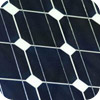Solar Panels
Introduction
We all know that renewable sources of energy reduce carbon dioxide (CO²) emissions, but they’re often not considered to be something that’s affordable for the average Joe. Thanks, though, to the increasing cost of fossil fuels and continued research into mass production techniques, alternative sources of energy are becoming much more affordable and relevant to us.

When compared to the other potential sources of renewable energy that can be generated for and by individual homes, such as wind turbines and hydro-power, solar panels have a number of distinct advantages. They are the easiest to install, create no noise pollution, require little maintenance and are the least aesthetically damaging; they look similar to roof windows or skylights.
They are also the only form of renewable energy that is accounted for in the Energy Efficiency Ratings that become mandatory for UK property sales as of July 2007.
Types of Solar Panel

Energy from the sun is gathered using panels, or ‘modules’, which can be added together to deliver sufficient energy for a household, depending on the size, location and orientation of the property. Use the link below for more information:
Orientation of solar panels

To produce a decent quantity of electricity or hot water, solar panels should be mounted on roof surfaces that have the optimal orientation and angle of inclination.
In the Northern Hemisphere, greatest output from solar panels can be achieved when they are placed on unshaded roof surfaces that face due South. In addition the panels should be mounted at an angle of 35 to 40 degrees to the horizon:
- Photovoltaic cells will require roof space of at least 10m² (pointing southwest, south or southeast) that is structurally sound to take the weight of the solar panels.
- Solar hot water panels will need a roof space of at least 2m² (pointing southwest, south or southeast) that is structurally sound to take the weight of the solar panels.
Planning permission
Solar panels are regarded as ‘permitted development’ if they are inserted into the existing plane of the roof and do not sit more than 10cm (4in) above the roof line.
If your property is a listed building, or is in a conservation area, or the solar panels will raise the highest point of the existing roof or increase the total volume of the property, you may need to apply for planning permission. If in any doubt, contact your local council for advice.
Amount of energy produced
The amount of energy produced by solar panels depends on a number of factors including area and efficiency of panels, degree of shading and orientation so average figures only are given here:
PV Cells
- An average UK household uses 4600 kWh of electricity each year. Your household’s consumption will be detailed on your bills.
- The output of a photovoltaic solar panel is measured in kWp = kilowatt peak which refers to its peak output in full sunlight.
- A typical domestic installation has 2kWp, which requires 10-15m² roof space and £4000-£9000 to be installed, and can produce 1500 kWh of electricity each year, thereby cutting your electricity bill by around 30%.
Solar heated water
- An average UK household uses 20,100 kWh of gas each year, most of which is used to heat water for central heating, washing and bathing. Your household’s consumption will be detailed on your bills.
- 1m² of solar water heating panels can produce 1000kWh energy per year and a typical installation requires about 3m² of unshaded roof space and costs £2000-£3000 for flat plates or £3500-£5000 for evacuated tube panels.
Solar heated water panels do not contribute to your central heating costs, since there is little sun during the winter which is precisely when central heating is required. However, the hot water used in washing machines, taps and showers is generated by solar water panels, so they can take care of almost all your hot water needs during the summer and approximately 55% of the non-central heating hot water during the winter.
- You can therefore expect solar water heating panels to reduce your annual gas bill by approximately 15%.
Grants
To encourage us to switch to environmentally friendly energy sources and cut carbon dioxide emissions, the UK government provide grants to help with the cost of installing solar water heating systems in domestic properties. Applications are normally approved if the following qualifying criteria for the existing property are met:
- At least 270mm loft insulation
- Where applicable, cavity walls are insulated
- Low energy lightbulbs are fitted in all appropriate light fittings
- Heating system is controlled by a room thermostat and a programmer or timer device
- Solar heated water - a grant of upto £400 or 30% of the VAT-exclusive price, whichever is the smaller is available to each household.
- Photovoltaic solar panels - a grant of upto £3000 per kWp installed, or maximum of £15000 or 50% of the total VAT-exclusive installed price.
- No grants are available for DIY-installed solar panels. To find accredited installers and products, visit:
Low Carbon Buildings (lowcarbonbuildings.org.uk)
Further information and useful links
- Improve the efficiency of your home with energy saving products
- Hot water systems
- Building Regulations Part L: Conservation of fuel and power
- Plumbing & heating topics
Site Pages
Featured Articles





